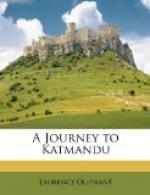In another part of the establishment was a gang of men engaged in twisting gun-barrels, turning out wonderful productions, considering the rude method employed.
The stocks were more easily fabricated, and the whole musket justified the pride with which it was exhibited; but Jung is no longer satisfied with the productions of the Nepaulese gunmakers. He visited a gun-manufactory at Birmingham, and was most disagreeably surprised by finding how different was the English mode of manufacturing the implements of war from that employed in Nepaul.
In England Jung had seen brass guns cast by the score during his short visit to the foundry. Here they were being cast at the rate of one every two or three months. The metal is not allowed to run into the mould in a continuous stream, but is ladled in, thereby rendering the gun liable to flaws. There were many other improvements which it would have been obvious to a practised eye were needed in the gun-factory of Nepaul; and it was plain enough that everything was rough and clumsy; but Jung had paid especial attention to these subjects while in England, and intends speedily to introduce an improved system. How long it will be ere he will have a steam-foundry established in Katmandu time alone can show.
CHAPTER XII.
Kindness of the Mahila Sahib—His motive—Drawing-room ornaments—Visit to the palace of Jung Bahadoor—A trophy of the London season—Grand Durbar at the reading of the Queen of England’s letter—Dress of the officers—Review of troops—Dancing boys.
The Mahila Sahib, the younger brother of his Majesty, was a very pleasant-looking young man, with a much more amiable expression of countenance than his royal brother, and professed to be one of Jung’s greatest friends and allies. As a compliment to the minister, he politely requested us to pay him a visit, an invitation of which we were glad to avail ourselves, since it proved his kindly feeling towards our host, whilst it gave us an opportunity of inspecting the menage of a Nepaulese Prince Royal.




